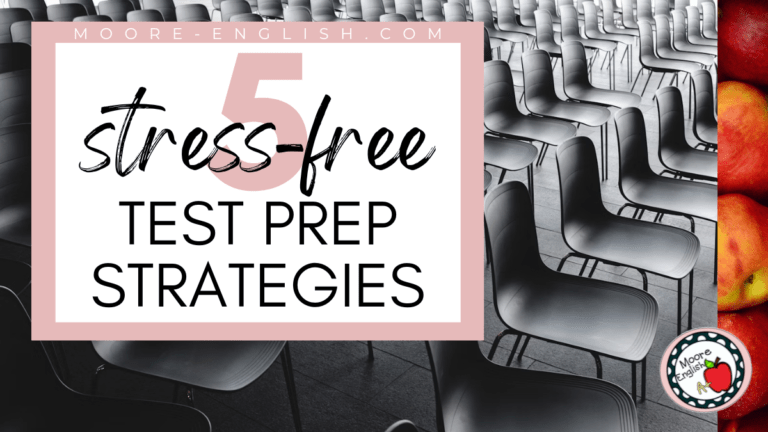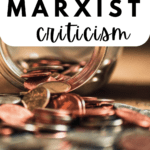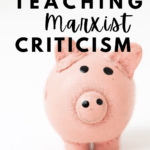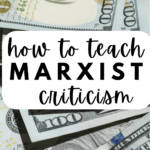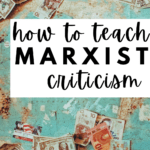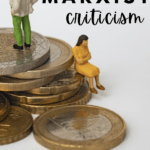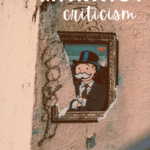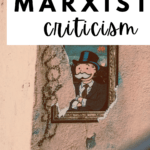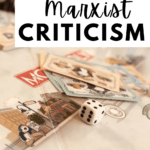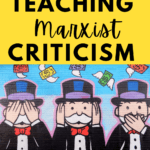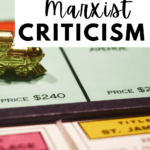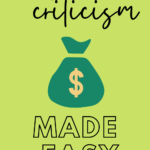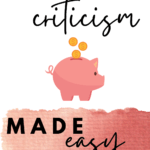When my students study literary criticism, I usually introduce Marxist criticism after feminist criticism. In part, I introduce these two lenses in close order because they are both political lenses. They’re not political in the sense of partisan politics. But they both deal with how literature navigates issues of power and privilege.
However, I usually introduce Marxist criticism after feminist criticism because students stumble over the “Marxist” title. Students know Karl Marx from their social studies classes. And they know about communism from reading The Crucible. Sometimes that leads students to believe that Marxist criticism is all about communism. So I spend a lot of time upfront addressing this misunderstanding.
From that point forward, we apply Marxist criticism by evaluating how social class and privilege intersect. At the high school level, I work to keep criticism as straightforward as possible. In other words, we’re asking these questions over and over:
- First, what social classes or hierarchies appear in the text?
- Second, which characters have privilege? What does privilege look like in the text? How does access to or distance from privilege affect a character?
- Similarly, how does the text treat characters from various social classes? How does membership in a particular social class affect a character’s actions and/or how they are treated by other characters?
This post this post may contain affiliate links. Please read the Terms of Use.
Introducing Marxist Criticism
At the high school level, students don’t need all the vocabulary of Marxist criticism. However, the concept of “privilege” is so closely related to Marxist criticism that we always explore this term. Most of my students are at least familiar with the concept of privilege even if they can’t define it. For this reason, the essay “Privileged” by Kyle Korver can be a good text for introducing and unpacking this term.
Oftentimes, I find short works to be useful in exploring a new concept. The brevity of poetry can make it ideal for exploring a new idea. To practice applying Marxist criticism, teachers might consider “Richard Cory” by Edwin Arlington Robinson. This poem has a straightforward “plot.” The content of the poem is also high interest, so students will be engaged. Then, students can practice applying Marxist criticism to explore the relationship between Richard Cory and the speaker. Grab “Richard Cory” and two more of Robinson’s most-famous poems in this great bundle!
Additionally, a short story like “A Worn Path” by Eudora Welty is a good tool for practicing Marxist criticism. For one, this is a short short story, and the plot is clear and easy to follow. Furthermore, social class plays a clear role in how the main character is treated and how she interacts with the white, urban world. Read it here.
Short Stories
Short stories are the primary way that I teach students to apply literary criticism. These three short stories provide readers with plenty of opportunities to evaluate how social class and privilege affect a text’s meaning.
- First, “A White Heron” by Sarah Orne Jewett is straightforward enough that students can usually read the story independently. Then, students can apply literary criticism with a partner or small group. Read it here.
- Second, “Berenice” by Edgar Allan Poe may seem like an unusual suggestion. However, this text is high interest, and the main character’s life would be wildly different if he didn’t have privilege. He simply could not have gotten away with his crimes if his social class didn’t protect him. Read it here.
- Finally, “Winter Dreams” by F. Scott Fitzgerald is the longest short story on this list. My students usually enjoy this story because the main characters are so infuriating! The social classes of the main characters play a clear part in their interactions. Of the texts mentioned so far, this is the only one with a character actively working to advance his social class. This text also lends itself to feminist criticism. Read it here.
Grab all my lesson plans for these short stories plus “A Worn Path” and lessons for 5 other short stories in the 9-12 Short Stories Bundle!
Longer Works
Longer texts take more time to read, so I usually incorporate longer works after we have tried different critical lenses. I also like to choose texts that lend themselves to a variety of critical lenses. All the longer works on this list would be good candidates for historical criticism, too! Exploring the intersection of history and literature also adds another layer of complexity to Marxist criticism.
- First, The Crucible by Arthur Miller is an ideal candidate for applying several critical lenses. The allegory for McCarthyism lends itself to historical criticism. Also, Miller makes it clear that social class plays an important part in the Salem Witch Trials. Check out my favorite activities for teaching The Crucible.
- Similarly, The Great Gatsby by F. Scott Fitzgerald is one of the first texts I think of when discussing Marxist criticism. The symbolism of East and West Egg and the Valley of Ashes lends itself beautifully to evaluating the role of social class and privilege in the text. These are my favorite activities for teaching The Great Gatsby.
- Additionally, To Kill a Mockingbird by Harper Lee is not a text I usually associate with literary criticism. However, social class is an unavoidable part of teaching and reading this novel. The text also covers issues related to race and gender, so it suits a variety of critical lenses. I also pair To Kill a Mockingbird with a variety of related texts that provide a richer view of Maycomb.
- Finally, Pride and Prejudice by Jane Austen is a text that clearly lends itself to Marxist criticism. Because social class plays such an important part in this novel, I usually start students with this primer about class in the Victorian Era. I also love this collection of activities for helping students engage with Pride and Prejudice.
Honorable Mentions
These two texts lend themselves to Marxist criticism although they are not my first choices.
First, the poem “The Last of the Light Brigade” by Rudyard Kipling focuses on the lives of the brave survivors of “The Light Brigade.” Because this premise of this poem is based on another poem, it takes a little more time to get students to the Marxist criticism. That being said, this poem also connects well with Pride and Prejudice because it emphasizes the hardship of life in Victorian England. Read it here.
Finally, Julius Caesar by William Shakespeare is one of my favorite plays to read with students! While this play more closely aligns with archetypal criticism, social class also plays a role in the drama. The citizens in the play are cast as a moronic, gullible mob. That they come from the plebian class and not from the patrician class of the main characters suits Marxist criticism. Julius Caesar also goes well with these unexpected text pairings!
What other texts would you recommend for teaching Marxist criticism?
Further Reading
Since literary criticism is one of my passions, I’ve written quite a bit about it. Check out these related posts and resources:
- 5 Reasons to Include Literary Criticism, and 5 Ways to Make it Happen
- How to Introduce Deconstructionist Literary Criticism
- Teaching at the Intersection of History and Literature
- 13 Texts for Introducing Psychoanalytical Criticism
- 8 Ways to Bring Creativity into the Classroom
- 6 Texts for Teaching Biographical Criticism
- 40 Texts for Teaching Literary Criticism
- Historical and Biographical Criticism
- Deconstructionist Criticism Bundle
- All Literary Criticism Resources
- Introducing Literary Criticism
- Feminist Criticism Bundle
- Historical Criticism

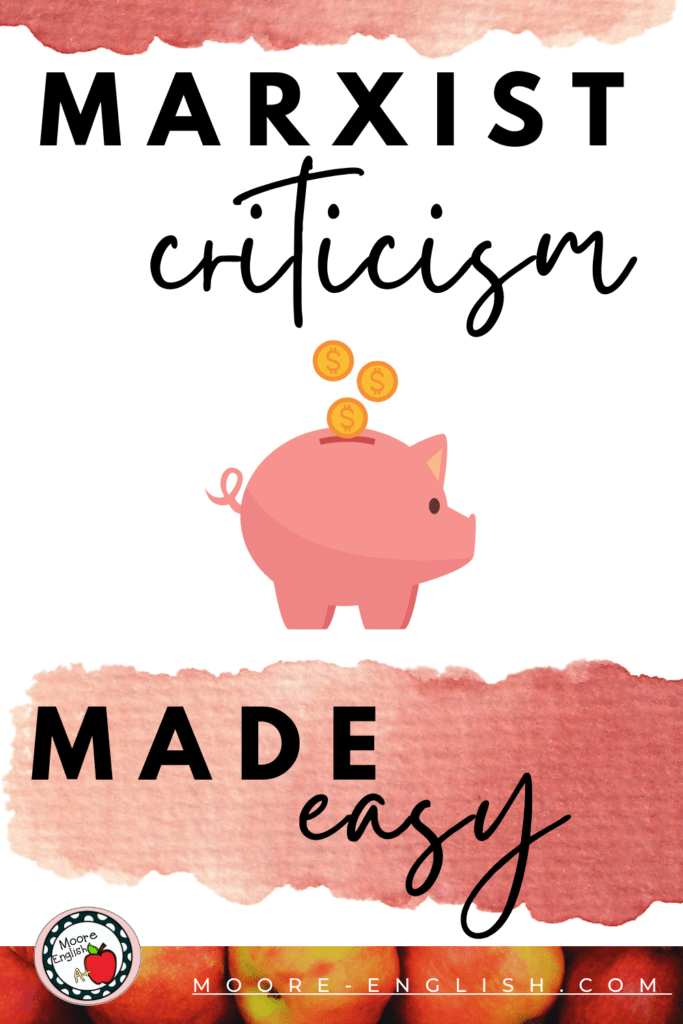
Photos by Joshua Hoehne, BP Miller, Kathy Marsh, Julian Hochgesang, Mathieu Stern, Christine Roy,
Jason Leung , Giorgio Trovato, Fabian Blank, Josh Appel


